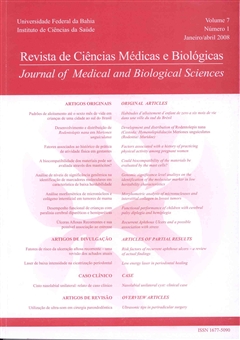Risk factors of recurrent aphthous ulcers – a review of actual findings
DOI:
https://doi.org/10.9771/cmbio.v7i1.4361Keywords:
Stomatitis, aphthous, Oral medicine, Mouth mucosa-Recurrent Aphtous UlcerationAbstract
The Recurrent Aphthous Ulceration (RAU) is the most common oral mucosal disorder, attacking mainly non-keratinized areas. It is characterized by painful, recurring, superficial ulcers, surrounded by erythematous haloes. The ulcers are classified, according to clinical characteristics, as minor ulcers, major ulcers and herpetiform ulcers. Its etiology is multifactorial and can be associated with family history and local, systemic and genetic factors. The diagnosis is fundamentally made through anamnesis and clinical exam, because no laboratory procedures exisst to confirm the diagnosis. To date, there is no curative therapy to prevent the recurrence of ulcers, and all available treatment modalities can only reduce the frequency and severity of the lesions. Based in the actual findings, the main objective of this paper is to relate and discuss the main risk factors of the recurrent aphthous ulceration, found in the literature, and so it contributes for better understanding this disorder.Downloads
Download data is not yet available.
Downloads
Published
2008-10-17
How to Cite
Alves, P. M., Ramalho, L. da S., Oliveira, R. S. de, Cavalcanti, A. L., & Queiroz, L. M. G. (2008). Risk factors of recurrent aphthous ulcers – a review of actual findings. Journal of Medical and Biological Sciences, 7(1), 76–84. https://doi.org/10.9771/cmbio.v7i1.4361
Issue
Section
Artigo de Atualização
License
The Journal of Medical and Biological Sciences reserves all copyrights of published works, including translations, allowing, however, their subsequent reproduction as transcription, with proper citation of source, through the Creative Commons license. The periodical has free and free access.


